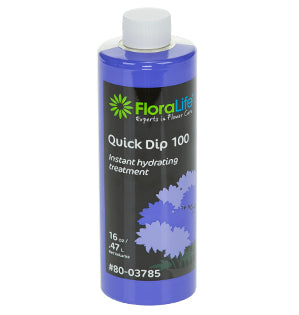Bird of Paradise Floral Design
In this how-to video Leanne creates a dramatic formal linear design using the tropical Bird of Paradise combined with Exotic pincushion Protea, locally grown Clematis and foraged lichen covered branches from the Pacific Northwest Forest. While this is not a mix of flowers that you would normally expect, you will love the resulting color harmony. Enjoy
Video Transcription
Welcome to the Flower School .com video library. I'm Leanne Kesler, Director of the Floral Design Institute, and today, I want to share with you a fabulous linear design, featuring bird of paradise.
Starting with bird of paradise, they're so grand and fabulous, and mother nature gets you the color harmony before you even begin, so orange, violet, and green, a triad. Then filling in with veronica, clematis, some protea, carnations, chrysanthemums, then foliages for the green. Expanding upon the green using a lichen-covered branch, just sets right onto the container, pre-soaked foam with flower food, then anchoring it in place using a taped wire, that I bend into a U, making a hairpin, then just securing that right down in the foam.
First is the bird of paradise. You want those to be placed. Their stems are large. You want to make them secure and sturdy before you go further. I'm going to do an inward-line movement, so using two birds facing each other, sequencing smallest on the top, thinking about how tall I want it to be. Give it a cut, then a second cut, so that it gives it a wedge. Then placing it in, angling just a bit, bringing the second bird, a little shorter, second cut to wedge, and then facing so that the two birds are talking to each other.
To anchor the color down to the base of the design and establish the focal emphasis, that's where I use the protea. You can break them, because they are so sturdy, or cut them, whichever you're more comfortable with. Keeping them low, so that they draw your eye all the way down to the base of the arrangement, and shadowing another right behind, to continue bringing the eye down, nice and short, right to the base.
Once you've established the form, your line, your spacing, the emphasis, then it becomes fun. You think about enhancing the color harmony, adding textures, adding contrast, and of course, covering your mechanics. So the veronica, stripping down some of the foliage, so it keeps it nice and clean, letting it come up through the center, taking the purple from the birds and dropping it down, repeating that. A little bit of the clematis, cutting it down, and letting it come out to the side, balancing from the stick and taking the purple outward, a second piece. Then one more of the protea, bringing it around to the back, to carry that color from side to side. Then lastly, using the carnations and the chrysanthemums, just basing them very low to cover all the foam.
As I finish, I want to bring in a little more green. I've got the beautiful chartreuse, but I want some darker to go along with the stem. It can be as simple as just a stem or two of ruscus, tucked down low, darkening that center area, that draws you from front to back. As I think about that, I think about all the clematis, and using one more bit to draw your eye to the opposite side, then just a galax or two, to help break the line of the container right down in front. Now, as I finish this, the recipe is really quite easy. I started with two bird of paradise, then three pincushion protea, four carnation, one stem of chrysanthemums, two veronica, two stems of clematis, of course the beautiful lichen-covered branch, a bit of foam, two galax, and two Israeli ruscus. That's it. Working in twos mostly gives you a beautiful linear design.
When you work with dramatic flowers, like the bird of paradise, thinking in a linear fashion shows them to their greatest beauty. Just focus on elements and principles, and design away. Now, if you'd like more creative inspiration, check out our website at Flower School .com. If you have questions, you can reach us there, or pick up the telephone and give us a call at 503-223-8089. Now it's your turn. What are you going to create using the linear style? Take a picture, post it on social media, and be sure to tag Floral Design Institute. That way, we call can see as you do something you love.








